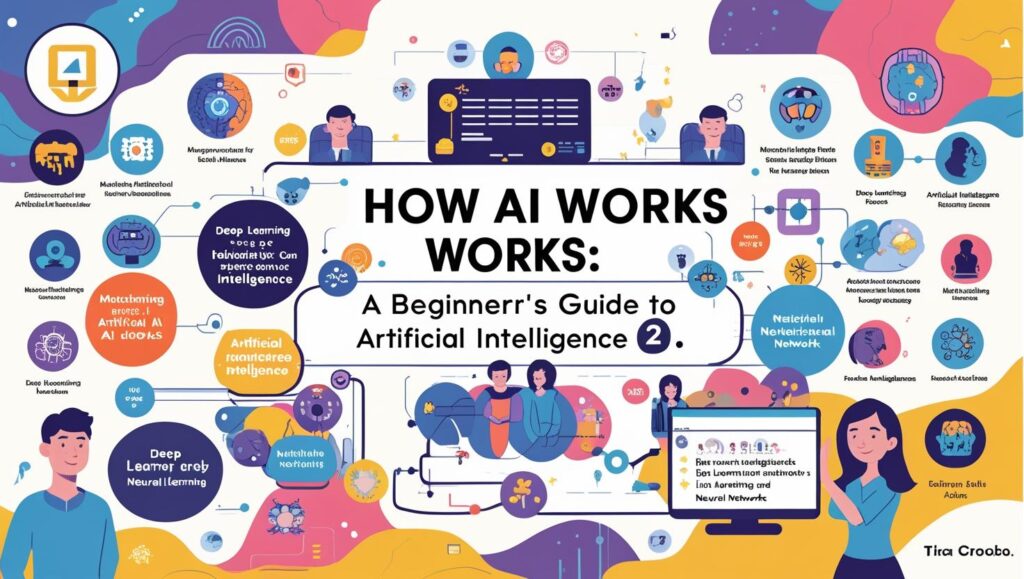
One of the most interesting and rapidly developing technologies of our day is artificial intelligence, or AI. It powers voice assistants like Alexa and Siri, suggests what to watch on Netflix next, and even aids in medical diagnosis. But even after hearing about it all the time, a lot of people are still curious about how AI works.
Don’t worry if you’re new to AI; this article will walk you through the basics of the technology and explain why it plays a role in our daily lives.
What Is Artificial Intelligence? How AI Works
The goal of the computer science discipline of artificial intelligence is to build devices or programs that can simulate human intelligence. This implies that AI systems are capable of making decisions, identifying patterns, learning from experience, and even comprehending natural language.
Simply put briefly, machine learning (AI) allows devices to “think” and carry out tasks that typically call for human intelligence.
Types of Artificial Intelligence
It’s useful to understand all kinds of artificial intelligence before exploring the way it works: How AI Works
- Narrow AI (Weak AI)
The most prevalent type of AI is this type. It is made to perform a specific function, such as playing games of chess, transforming spoken tongues, or realizing names. It lacks feeling and general intelligence. Google Translate, along with mail screening for spam, are two examples.
- General AI (Strong AI)
Machines that are able to understand, gain knowledge, and ask for information similarly to humans have the kinds of The use of AI is something that we find out about in science fiction films. Although there isn’t general artificial intelligence yet, researchers are working to create it.
- Superintelligent AI
a fictitious AI that is infinitely more intelligent than humans. Experts continue to discuss its dangers and consequences in moral terms even though it remains theoretical.
The Core Components of AI
So, How AI works Actually ? At its core, AI combines several key technologies and concepts:
Machine Learning (ML)
A branch of AI called machine learning involves teaching machines to learn from data and get better over time without explicit programming. For instance, a machine is able to recognize pet animals on its own if you show it hundreds of pics of them. How AI Works:
Three categories of machine learning exist:
- Supervised Learning: Labeled data, such as messages classified as spam or not, is used to teach the model.
- Unsupervised Learning: The model (such as customer segmentation) detects patterns in information without labels.
- Reinforcement Learning: By gratifying or disciplining the model, it picks up by making mistakes (like teaching a robot to walk).
Neural Networks
Neural networks are information-processing systems of interconnected nodes, such as neurons, that were inspired by the human brain. They serve as the foundation for many AI systems, particularly those that use deep learning.
Deep Learning
Large artificial neural networks with a lot of layers are made in deep learning, an improved type of deep learning. It powers innovations like natural language processing, self-driving cars, and the detection of faces.
Natural Language Processing (NLP)
Machines can comprehend, interpret, and react to human language thanks to natural language processing (NLP). It is the technology that powers voice-assisted chatbots, as well as the process the program.
How Does AI Learn?
Let’s say you are teaching a child to distinguish between apples and oranges. You tell them, “This is an orange,” or “This is an apple,” after giving them numerous examples. They eventually pick up on the distinctions—color, shape, and texture—and learn to distinguish them on their own. How AI Works:
AI functions similarly. It gains knowledge from data. Its ability to make precise predictions or decisions improves with the amount of high-quality data it earns. How AI Works:
This is a basic explanation of how AI learns:
- Data Collection: In order to learn, AI requires a large amount of data, including text, audio, numbers, and images.
- Data processing involves organizing, cleaning, and feeding the data into the robotic system.
- Model Training: Using this data, the AI model is trained to identify trends and connections.
- Testing & Evaluation: To determine the relevancy of the model, fresh data is used for testing.
- Improvement: The model is modified and additionally trained in light of the findings.
Everyday Examples of AI in Action
AI is already a part of everyday life and is not restricted to labs or tech companies. Here are a few instances from the actual world:
AI is used by smart assistants like Google Assistant, Alexa, and Siri to comprehend your voice commands.
- Social media: AI is used by Facebook and Instagram to filter content and recommend friends.
- Streaming Services: Based on your viewing preferences, Netflix and YouTube calculate videos and series.
- E-commerce: Amazon employs AI to provide price variation and product recommendations.
- Healthcare: AI supports surgery, disease prediction, and imaging in medicine.
- Finance: AI uses chatbots to provide customer service, automate trading, and identify fraud.
The Benefits of AI
AI offers several advantages that make it a powerful tool:
- Efficiency: AI is capable of working around the clock without getting tired.
- Accuracy: In repetitive tasks, it removes human error.
- Speed: Compared to humans, AI processes vast amounts of data far more quickly.
- Personalization: It provides experiences that are customized, such as content recommendations or personalized shopping.
The Challenges and Concerns
Despite its benefits, AI also brings some concerns:
- Job Displacement: Certain jobs may become obsolete as AI automates tasks.
- Bias in Data: AI may produce untrue outcomes if it learns from biased data.
- Privacy Concerns: AI systems frequently gather a lot of personal information.
- Lack of Transparency: We don’t always know when specific AI systems, like deep learning, work to make decisions; they’re termed “black boxes.”
Fairness, accountability, and transparency are the main focuses of the growing field of ethical AI improvement.
The Future of AI
- AI is still developing. In the future, we might observe:
- AI assistants that are more like humans
- Intelligent robots for hospitals and processing
- AI-powered education customized for every learner
- Intelligent cars that are safer and more effective
Although the precise ways in which AI will influence the future are unknown, one thing is definite: it will be significant.
Conclusion:
Though it may sound complicated, artificial intelligence is really just machines using data to learn and make intelligent decisions. AI is already making life simpler, quicker, and more connected, whether you’re using a voice assistant, getting product recommendations, or reading the news online. How AI Works:
As a novice, knowing the fundamentals of AI’s operation enables you to not only stay current with technology but also consider its social implications. The more you learn, the more equipped you will be to navigate—and perhaps even influence—the AI-powered future.
What exactly is Artificial Intelligence (AI) in simple words?
AI is when computers or machines are designed to act like humans by learning, reasoning, and solving problems. For example, when Siri answers your question, that’s AI at work.
How is AI different from normal computer programs?
A normal program follows fixed instructions written by humans. AI, on the other hand, can learn from data and improve its performance without being reprogrammed each time.
What are some everyday examples of AI that I might be using without knowing?
Voice assistants (Alexa, Google Assistant, Siri)
Netflix or YouTube recommendations
Spam filters in email
Google Maps traffic predictions
Online shopping suggestions
Is Artificial Intelligence the same as Machine Learning?
Not exactly. AI is the broader field that covers all machines that simulate human intelligence. Machine Learning (ML) is a part of AI that helps machines learn from data.
Can AI think and feel like humans?
No. Today’s AI can analyze data and make smart decisions, but it doesn’t have emotions, consciousness, or human-like understanding.
What are the main types of AI (Narrow AI, General AI, Super AI)?
Narrow AI (Weak AI): Focuses on one task (like chatbots, language translation).
General AI (Strong AI): A future goal where machines think like humans.
Super AI: A theoretical concept where machines surpass human intelligence.
How does AI learn from data?
AI learns by analyzing patterns in large amounts of data. For example, if you show it thousands of pictures of cats and dogs, it can learn to tell the difference between them.
Will AI replace human jobs in the future?
AI will automate some tasks (like data entry, customer support), but it will also create new jobs in AI development, data science, robotics, and other fields. People with tech and creative skills will still be in high demand.
Is AI safe to use, and what are the risks?
AI is safe when used responsibly, but risks include data privacy issues, biased decision-making, and job displacement. That’s why ethical AI development is so important.
What skills should I learn if I want to start a career in AI?
Start with programming (Python is popular), math basics (statistics & probability), and learn about machine learning, data analysis, and neural networks. Tools like TensorFlow, PyTorch, and Scikit-learn are widely used.

